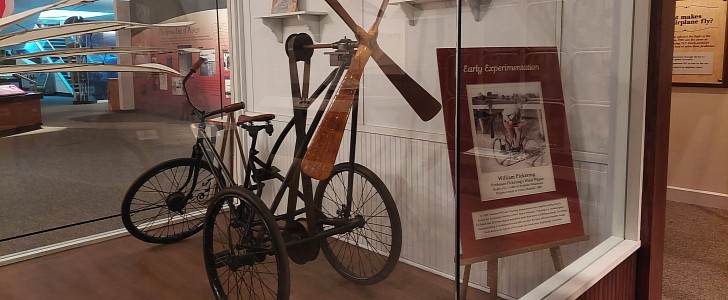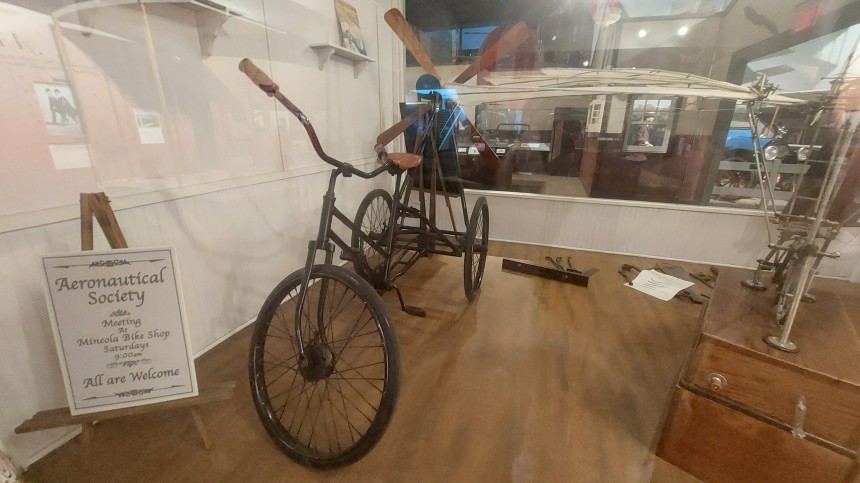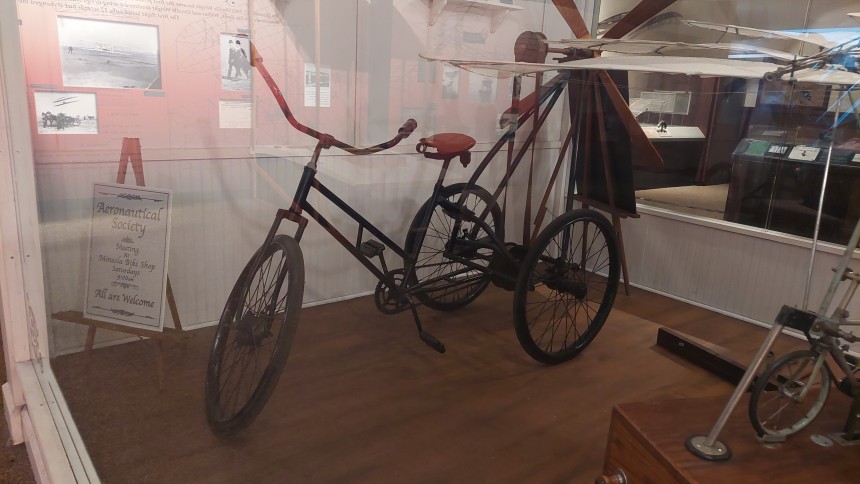Wheeled machines used to look pretty darn wacky at the turn of the 19th and early 20th centuries. The most hilarious of these early machines must be the penny farthing. The bicycle with the absurdly large front wheel, you know the one. But there's something about a pedal-powered tricycle with a massive propeller sticking out its backside that's pure comedy.
But despite how it looks, there was a real method behind the hilarity that shaped this bizarre creation. It was the brainchild of a man who may not have had a complete understanding of aerodynamics, not that many people did at the time. But whether he knew it or not, Professor William Pickering was conducting pioneer research into the mechanics of propeller-driven manned airplanes.
As it turns out, the very earliest beginnings of heavier than air powered flight had their roots less so in the automotive industry than it did in, of all things, bicycle making. Be in Glenn H Curtiss, the Wright Brothers, or Professor Pickering himself. There was something about bike sprockets and thin, spoked wheels that beautifully transferred to canvas wings and barely passable powered flight. It wouldn't stay like that primitive for long, thankfully.
In the interim, the only way aeronautical engineers could figure out the real nuts and bolts of the controlled heavier-than-air flight was through trial and error. When you're trying to make glorified canvas kites with engines fly, that sounds like some dangerous prospects. That's where Boston, Massachusetts native Professor Pickering's bizarre invention comes into its own. On the face of it, it's a remarkably quirky and interesting concept.
It started with a custom metal tricycle chassis, presumably made of tube steel or cast iron, mated to three perfectly normal bicycle wheels and tires. But the real lunacy in the whole deal comes at the back end, where a belt drive propelled by the pedals in the middle turns a spinning metal driveshaft. At the end of this contraption, a large wooden propeller was mounted. Now, you might be tempted to call the thing balderdash.
There's no way a propeller powered by two human legs could possibly make a difference in performance, right? Professor Pickering discovered that different combinations of blade number, size, thickness, weight, and especially the angle of attack influenced how much boost the propeller could give to the tricycle. It wasn't a huge difference at such low speeds, but it was at the very least noticeable enough to make some profoundly important discoveries in aeronautics.
By timing his speed along a pre-determined distance, Pickering could determine what combinations of these aforementioned propeller blade qualities were the most effective in different scenarios and environments. As it turned out, these insignificant little differences at normal cycling speeds magnified as people began to take to the air. It was found that propellers with fixed-pitch weren't efficient over the full spectrum of altitudes, weather conditions, and other hazards an airplane was liable to expect in flight.
For example, fixed-geometry props configured for, say, higher top speeds would struggle to perform efficiently when simply trying to maintain cruising speeds. In the case of this nutty Boston professor's propeller trike, every time he wanted to try a different design required changing the entire propeller assembly. Even so, it made palpable differences in performance as testing carried on. Research of this caliber culminated in the first patented automatic variable pitch "airscrew" by the English inventor L.E. Baynes in 1919.
The French aerospace firm Ratier was credited with the first practical application of a variable pitch propeller back in 1932. Other famous early variable pitch propellers were designed by the American Curtiss Wright and Hamilton Standard companies. By the time of the Second World War, variable geometry propellers were standard issue on nearly all Allied and Axis aircraft. Today, virtually all modern propeller-driven airplanes of any kind, be it single-engined Cessnas or a C-130J Super Hercules, use this technology.
It's all thanks in no small part to the zany experiments of a Bostonian professor none of us had even heard of before a faithful replica of his invention came across our path at our visit to the Cradle of Aviation Museum in Garden City, New York. Safe to say, it looks even more hilarious up close and personal.
As it turns out, the very earliest beginnings of heavier than air powered flight had their roots less so in the automotive industry than it did in, of all things, bicycle making. Be in Glenn H Curtiss, the Wright Brothers, or Professor Pickering himself. There was something about bike sprockets and thin, spoked wheels that beautifully transferred to canvas wings and barely passable powered flight. It wouldn't stay like that primitive for long, thankfully.
In the interim, the only way aeronautical engineers could figure out the real nuts and bolts of the controlled heavier-than-air flight was through trial and error. When you're trying to make glorified canvas kites with engines fly, that sounds like some dangerous prospects. That's where Boston, Massachusetts native Professor Pickering's bizarre invention comes into its own. On the face of it, it's a remarkably quirky and interesting concept.
It started with a custom metal tricycle chassis, presumably made of tube steel or cast iron, mated to three perfectly normal bicycle wheels and tires. But the real lunacy in the whole deal comes at the back end, where a belt drive propelled by the pedals in the middle turns a spinning metal driveshaft. At the end of this contraption, a large wooden propeller was mounted. Now, you might be tempted to call the thing balderdash.
By timing his speed along a pre-determined distance, Pickering could determine what combinations of these aforementioned propeller blade qualities were the most effective in different scenarios and environments. As it turned out, these insignificant little differences at normal cycling speeds magnified as people began to take to the air. It was found that propellers with fixed-pitch weren't efficient over the full spectrum of altitudes, weather conditions, and other hazards an airplane was liable to expect in flight.
For example, fixed-geometry props configured for, say, higher top speeds would struggle to perform efficiently when simply trying to maintain cruising speeds. In the case of this nutty Boston professor's propeller trike, every time he wanted to try a different design required changing the entire propeller assembly. Even so, it made palpable differences in performance as testing carried on. Research of this caliber culminated in the first patented automatic variable pitch "airscrew" by the English inventor L.E. Baynes in 1919.
The French aerospace firm Ratier was credited with the first practical application of a variable pitch propeller back in 1932. Other famous early variable pitch propellers were designed by the American Curtiss Wright and Hamilton Standard companies. By the time of the Second World War, variable geometry propellers were standard issue on nearly all Allied and Axis aircraft. Today, virtually all modern propeller-driven airplanes of any kind, be it single-engined Cessnas or a C-130J Super Hercules, use this technology.












